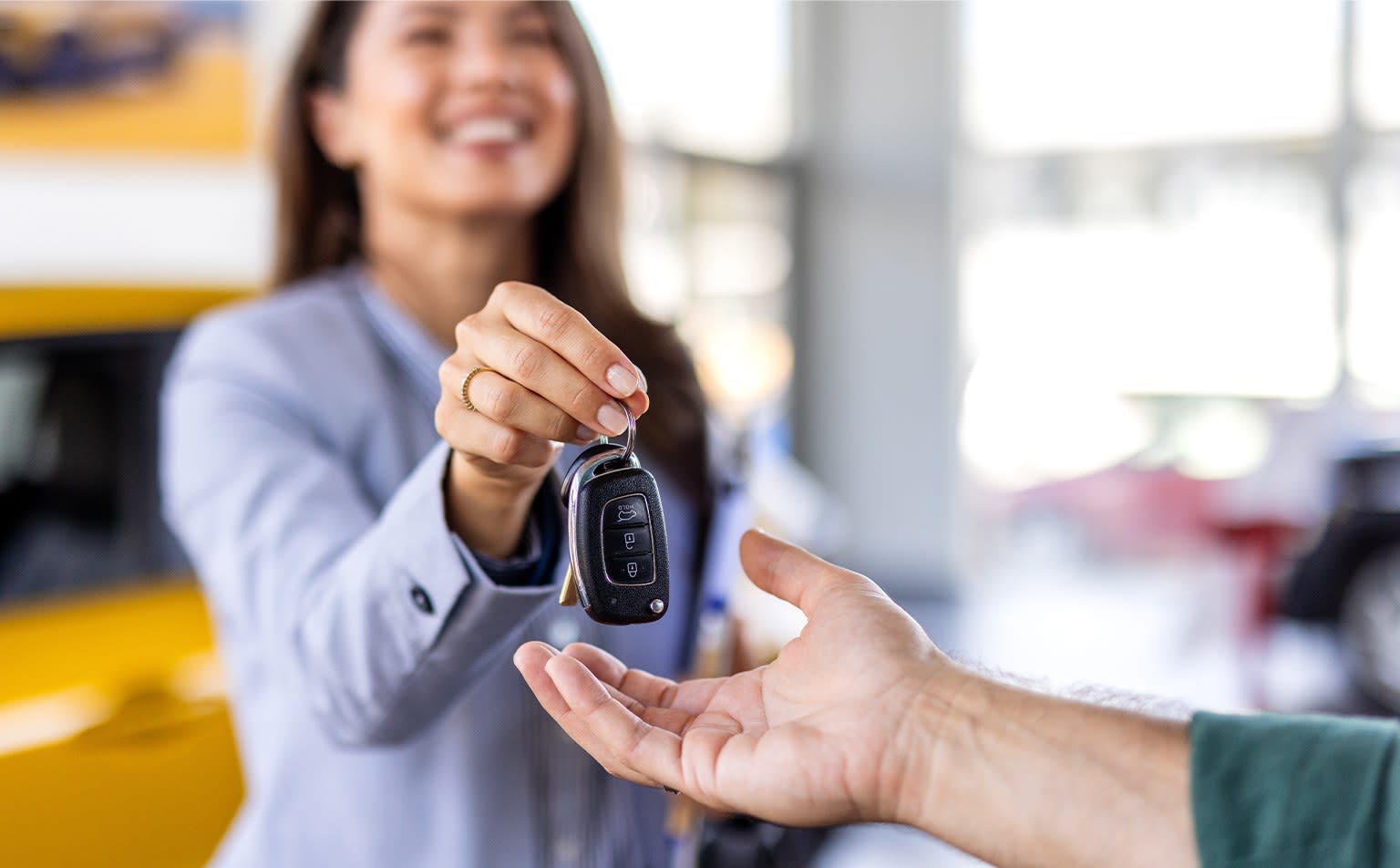
Expert Guide: How To Trade In A Car
Proven Expert Tips for Maximizing Your Vehicle's Trade-in Value
Looking to trade in your car? This guide from Aschenbach Automotive Group on how to trade in a car will help you maximize your trade-in process by covering everything you need to know. You’ll learn how to evaluate your car’s value, prepare it for trade-in, negotiate with dealers, and handle negative equity. Follow these steps to get the best deal on your trade-in and figure out how trading in a car works. Visit us today at any of our dealerships across Pennsylvania, Maryland, and Virginia.
What to expect from this article:
Knowing your car’s trade-in value and having the right documents are critical for negotiating effectively and ensuring the process of trading in a car goes smoothly.
Trading in at a dealership is often more convenient and financially beneficial than selling privately, despite potentially lower prices.
Managing equity, both positive and negative, can significantly impact your trade-in experience, influencing your financing options and overall savings.
Making the Most of Your Trade-in Value
Knowing your car’s trade-in value and the best way to trade in a car is crucial. It’s like walking into a negotiation with all the right cards in your hand. Researching your car’s current value using tools like Kelley Blue Book empowers you to negotiate effectively and secure a fair price. Remember that demand for your specific vehicle can greatly influence trade-in offers: when there is high demand for certain models, especially during specific seasons or market shortages, dealerships may offer better deals. Knowing how to trade in a car can be a game changer when you’re sitting across from a dealer. Trading in your vehicle at a car dealership, like those in Aschenbach Automotive Group, offers a much simpler and quicker process compared to selling privately.
Positive equity gives you a financial edge, making your car worth more than what you owe. Conversely, negative equity occurs when your car’s value is less than your remaining loan balance. Knowing where you stand and how to trade in a car can significantly impact your trade-in strategy and the deals you can secure.
Trade-in vs. Private Sale: Why Selling to a Dealer Is the Smarter Choice
Selling a car privately might seem like a way to get more money and the better method of how to trade in a car, but it often comes with hidden costs and significant effort. The process can be overwhelming, from advertising and detailing to handling repairs and legal responsibilities. Not to mention dealing with unreliable buyers, whether a private party or a dealer, means you need to understand your buyer to ensure fair negotiations and prepare the right documentation. Managing test drives can also lead to unexpected delays and liabilities.
In contrast, trading in your vehicle at a dealership offers several benefits:
A hassle-free and secure process.
Dealerships handle everything from appraisal to paperwork, saving you time and stress.
Tax savings, as sales tax is only paid on the difference between the trade-in value and the purchase price of your next car.
Trade-ins can enhance the overall value you receive during the car trading process.
Selling to a private party can sometimes yield a higher price, but it involves more effort, legal considerations, and time compared to trading in at a dealership. The decision on how to trade in a car ultimately hinges on your priorities. While private sales might offer slightly higher prices, the convenience, security, and financial benefits of trading in at a dealership often outweigh the potential extra cash. With dealerships, you avoid the headaches of marketing and negotiating with buyers, making it a smarter financial choice in the long run. If you choose to sell your car privately, be prepared for a more involved process compared to trading in. Learn more about trade-ins vs. private sales on our blog.
How to Trade In a Car With Negative Equity
Negative equity occurs when your car’s loan balance exceeds its market value, a situation many car owners face due to rapid depreciation, small down payments, or high-interest loans. To determine how to trade in a car with negative equity, compare your loan payoff amount with your vehicle’s current market value using reliable sources like Kelley Blue Book or a dealership appraisal.
Trading in a car with negative equity is possible, but the remaining balance is typically rolled into your new car loan, increasing the total loan amount. This means you could end up owing more on your new vehicle, so it’s crucial to explore strategies to manage this situation effectively. Paying the difference in cash, choosing a less expensive new car, or even leasing instead of financing are viable options when it comes to how to trade in a car.
Another strategy is to delay the trade-in while making extra payments toward the principal to reduce negative equity. This can help you minimize long-term financial effects and secure a better deal when you’re finally ready to trade. Remember, lenders have varying limits on how much negative equity can be incorporated into a new loan, often influenced by your credit score and the new vehicle’s price. Learn more about how to trade in a car on our blog.
Positive Equity on a Car: What It Means & How to Benefit From It
Positive equity means your car’s current market value is higher than the remaining balance on your auto loan. To determine if you have positive equity and how to trade in a car, subtract your loan payoff amount from your car’s current value using tools like Kelley Blue Book or a dealership appraisal. This financial edge can significantly benefit your trade-in process.
Building positive equity involves strategic practices such as:
Choosing a model that holds its value
Making larger down payments
Opting for shorter loan terms
Maintaining your vehicle diligently
Having positive equity offers several financial advantages of how to trade in a car. Firstly, it reduces the amount you need to finance for a new or used car, leading to lower monthly payments and potentially better refinancing interest rates. It also provides leverage in future vehicle transactions, allowing you to use your equity to upgrade to a newer or more advanced vehicle and secure more favorable financing terms. Learn more about positive equity on a car on our blog.
How to Prepare for a Car Trade-in: Documents & Tips
Before you head to the dealership, make sure you have all the necessary documents ready to streamline your car trade-in appointment and understand how to trade in a car. When preparing for a car trade-in, having the right documents is essential. These documents prove ownership and ensure the dealership has permission to legally accept the trade. Yet, what do you need to trade in your car?
Your vehicle’s title or loan payoff information if it’s still financed
Current registration
A valid driver’s license or ID
All sets of keys and remotes
These documents prove ownership and ensure the owner dealership has permission to legally accept the trade. Bringing service records, while not legally required, can demonstrate good maintenance and potentially increase your trade-in value. Researching your car’s value beforehand using tools like Kelley Blue Book and Edmunds for how to trade in a car can also help you understand its current market worth and set realistic expectations. Learn more about preparing your car for a trade-in on our blog.
How to Increase Your Vehicle’s Value
The condition of your vehicle plays a significant role in how to trade in a car. To significantly boost your car’s value, it's important to perform regular maintenance tasks, avoid accidents, address minor issues like burnt-out bulbs or low fluids, and clean and detail your car, both inside and out, to create a positive impact on appraisers
To increase your car’s trade-in value, make small fixes and provide detailed service records, address minor issues to prevent penalties and increase confidence in your vehicle’s condition, avoid aftermarket modifications, as they generally do not add value and can even decrease it, and return your vehicle to factory condition before trade-in, which is often recommended.
Attention to detail in vehicle maintenance and condition directly impacts its resale value when it comes to how to trade in a car. Consistent maintenance and timely repairs are essential for preserving a vehicle’s resale value. By taking these steps to trade in your car, you can ensure that you get the best value for your trade-in. Learn more about how to increase your vehicle's value on our blog.
How Do Dealerships Determine Trade-in Value?
Dealerships determine trade-in value using a combination of data and real-world market dynamics. They consider wholesale auction reports, retail listings, transaction data, seasonality, fuel prices, and regional tastes when it comes to how to trade in a car. At Aschenbach Automotive Group, the appraisal process involves several steps, including a VIN scan, history pull, mechanical inspection, cosmetic review, feature and mileage adjustment, market positioning, and auction backup.
Factors that significantly influence a vehicle’s trade-in value include:
Service records
Ownership history
Current condition
Tire and brake life
Market-friendly specifications
Key technology features
Transparency is key in the trade-in process. At Aschenbach Automotive Group, customers are invited to review appraisal numbers and ask questions to ensure they feel confident about the offer received and best determine how to trade in a car. This transparency helps build trust and ensures that you get a fair deal for your trade-in. Learn more about how dealerships determine trade-in value on our blog.
Determine Your Car's Value Today
Maximizing your vehicle’s trade-in value involves understanding the trade-in process, knowing your car’s value and how to trade in a car, and being well prepared. By trading in at a dealership, you can enjoy a hassle-free, secure, and financially advantageous experience. Whether dealing with negative or positive equity, strategic planning and maintenance can significantly impact the value you receive.
Remember, the key to a successful trade-in is preparation and knowledge. By following the tips and strategies of how to trade in a car, you can confidently navigate the trade-in process and secure a great deal on your next vehicle. So, take the first step today and turn your current car into a valuable asset for your future rides. Visit us today at any of our locations across Pennsylvania, Maryland, and Virginia!



